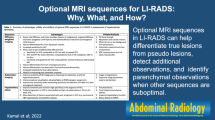Abstract
Background: We compared two T2-weighted turbo spin echo (TSE) sequences with a T2-weighted conventional SE (CSE) sequence to determine whether sequences derived from rapid acquisition with relaation enhancement such as TSE could replace CSE for the detection and subsequent characterization of focal liver lesions.
Methods: A total of 55 consecutive patients with 107 liver lesions underwent magnetic resonance imaging examination at 1.5 Tesla, with a constant imaging protocol. TSE pulse sequences were acquired with eight echo trains (repetition time [TR], 4718 ms; echo time [TE], 90 ms; acquisition time [TA], 4.03 min; and a symmetric k-space ordering scheme) and 11 echo trains (TR, 4200 ms; TE, 140 ms; TA, 4.40 min; and an asymmetric k-space ordering scheme) and compared with CSE (TR, 2300 ms; TE, 45/90 ms; TA, 9.53 min). Images were analyzed qualitatively by scoring image quality and artifacts and counting focal liver lesions by independent reading with consensus obtained for discrepancies. Quantitative analysis was performed by measuring signal-to-noise (S/N), contrast-to-noise (C/N), and tumor-liver signal intensity (T/L) ratios.
Results: T2-weighted TSE sequences provided better subjective image quality and reduced artifacts as compared with the T2-weighted CSE sequence. CSE and TSE sequences exhibited no statistically significant differences in liver S/N, lesion-liver C/N (CSE TE, 90 ms: 18.6±14.0; TSE TE, 90 ms: 16.5±12.9) and the detectability of focal liver lesions. Heavily T2-weighted TSE with a TE of 140 ms allowed correct characterization of focal liver lesions based on a T/L ratio of 3.0 in 84% of patients.
Conclusions: T2-weighted TSE sequences are as suited as CSE for the detection (TE, 90 ms), and appear to be superior for the characterization (TE, 140 ms), of focal hepatic lesions. Whether a single sequence, such as a double-echo TSE or a single-eho TSE sequence with a TE between 110 and 120 ms, might perform both functions as well or better than CSE is unkown. However, because of time savings, TSE eventually may be preferred over CSE.
Similar content being viewed by others
References
Reinig JW, Dwyer AJ, Miller DL, et al. Liver metastases: detection with MR imaging at 0.5 and 1.5 T. Radiology 1989;170:149–153
Foley WD, Kneeland JB, Cates JD, et al. Contrast optimization for the detection of focal hepatic lesions by MR imaging at 1.5 T. AJR 1987;149:1155–1160
Saini S, Modic MT, Hamm B, et al. Advances in contrast-enhanced MR imaging. AJR 1991;156:235–254
Constable RT, Gore JC. The loss of small objects in variable TE imaging: implications for FSE, RARE, and EPI. Magn Reson Med 1992;28:9–24
Chien D, Mulkern RV. Fast-spin echo studies of contrast and small-lesion definition in a liver metastasis phantom. JMRI 1992;2:483–487
Catasca JV, Mirowitz SA. T2-weighted MR imaging of the abdomen: fast spin-echo vs conventional spin-echo sequences. AJR 1994;162:61–67
Outwater EK, Mitchell DG, Vinitski S. Abdominal MR Imaging: evaluation of a fast spin-echo sequence. Radiology 1994;190:425–429
Low RN, Francis IR, Sigeti JS, et al. Abdominal MR imaging: comparison of T2-weighted fast and conventional spin echo, and contrast-enhanced fast multiplanar spoiled gradient-recalled imaging. Radiology 1993;186:803–811
Kaufman L, Kramer DM, Crooks LE, et al. Measuring signal-to-noise ratios in MR imaging. Radiology 1989;173:265–267
Itoh K, Saini S, Hahn PF, et al. Differentiation between small hemangiomas and metastases on MR images: importance of size-specific quantitative criteria. AJR 1990;155:61–66
Lombardo DM, Baker ME, Spritzer CE, et al. Hepatic hemangiomas vs metastases: MR differentiation at 1.5 T. AJR 1990;155:55–59
Armitage P, Berry G, eds. Statistical methods in medical research, 2nd ed. Oxford, UK: Blackwell Scientific, 1987
Hennig J, Nauerth A, Friedburg H. RARE imaging: a fast method for clinical MR. Mag Reson Med 1986;3:823–833
Melki PS, Jolesz FA, Mulkern RV. Partial RF echo-planar imaging with the FAISE method II. Contrast equivalence with spin-eco-sequences. Mag Reson Med 1992;26:342–354
Melki PS, Jolesz FA, Mulkern RV. Partial RF echo-planar imaging with the FAISE method I. Experimental and theoreticl assessment of artifact. Mag Reson Med 1992;26:328–341
Low RN, Hinks RS, Alzate GD, et al. Fast spin-echo MR imaging of the abdomen: contrast optimization and artifact reduction. JMRI 1994;4:637–645
Listerud J, Einstein S, Outwater EK, et al. First principles of fast spin echo. Magn Reson Quar 1993;8:199–244
Constable RT, Anderson AW, Zhong J, et al. Factors influencing contrast in fast spin-echo MR imaging. Magn Reson Imaging 1992;10:497–511
Semelka RC, Shoenut JP, Kroeker RM. T2-weighted MR imaging of focal hepatic lesions: comparison of various RARE and fat-suppressed spin-echo sequences. JMRI 1993;3:323–327
Melki PS, Mulkern RV. Magnetization transfer effects in multislice RARE sequences. Magn Reson Med 1992;24:189–195
Egglin TK, Rummeny EJ, Stark DD, et al. Hepatic tumors: quantitative tissue characterization with MR imaging. Radiology 1990;155:55–59
Hamm B, Fischer E, Taupitz M. Differentiation of hepatic hemangiomas from metastases by dynamic contrast-enhanced MR imaging. J Comput Assist Tomogr 1990;14:205–216
McFarland EG, Mayo-Smith WM, Saini S, et al. Hepatic hemangiomas and malignant tumors: improved differentiation with heavily T2-weighted conventional spin-echo MR imaging. Radiology 1994;193:43–47
Author information
Authors and Affiliations
Rights and permissions
About this article
Cite this article
Reimer, P., Rummeny, E.J., Wissing, M. et al. Hepatic MR imaging: comparison of RARE derived sequences with conventional sequences for detection and characterization of focal liver lesions. Abdom Imaging 21, 427–432 (1996). https://doi.org/10.1007/s002619900097
Received:
Accepted:
Issue Date:
DOI: https://doi.org/10.1007/s002619900097




